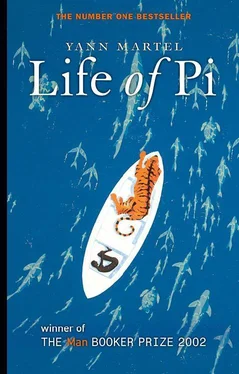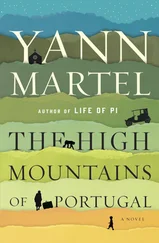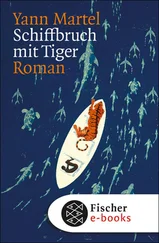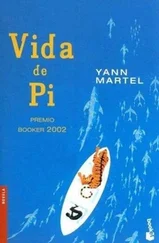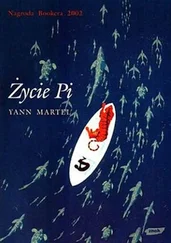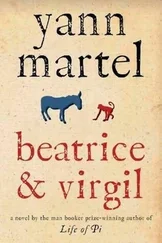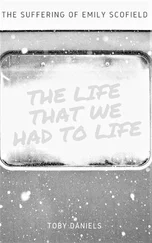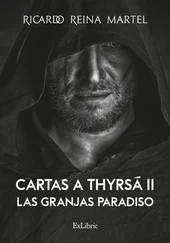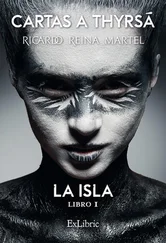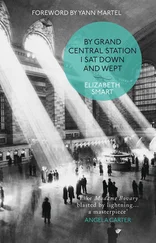Yann Martel - Life of Pi
Здесь есть возможность читать онлайн «Yann Martel - Life of Pi» весь текст электронной книги совершенно бесплатно (целиком полную версию без сокращений). В некоторых случаях можно слушать аудио, скачать через торрент в формате fb2 и присутствует краткое содержание. Год выпуска: 2002, ISBN: 2002, Издательство: Canongate Books, Жанр: Современная проза, на английском языке. Описание произведения, (предисловие) а так же отзывы посетителей доступны на портале библиотеки ЛибКат.
- Название:Life of Pi
- Автор:
- Издательство:Canongate Books
- Жанр:
- Год:2002
- ISBN:9781847674210
- Рейтинг книги:3 / 5. Голосов: 1
-
Избранное:Добавить в избранное
- Отзывы:
-
Ваша оценка:
- 60
- 1
- 2
- 3
- 4
- 5
Life of Pi: краткое содержание, описание и аннотация
Предлагаем к чтению аннотацию, описание, краткое содержание или предисловие (зависит от того, что написал сам автор книги «Life of Pi»). Если вы не нашли необходимую информацию о книге — напишите в комментариях, мы постараемся отыскать её.
Life of Pi — читать онлайн бесплатно полную книгу (весь текст) целиком
Ниже представлен текст книги, разбитый по страницам. Система сохранения места последней прочитанной страницы, позволяет с удобством читать онлайн бесплатно книгу «Life of Pi», без необходимости каждый раз заново искать на чём Вы остановились. Поставьте закладку, и сможете в любой момент перейти на страницу, на которой закончили чтение.
Интервал:
Закладка:
This, in a holy nutshell, is Hinduism, and I have been a Hindu all my life. With its notions in mind I see my place in the universe.
But we should not cling! A plague upon fundamentalists and literalists! I am reminded of a story of Lord Krishna when he was a cowherd. Every night he invites the milkmaids to dance with him in the forest. They come and they dance. The night is dark, the fire in their midst roars and crackles, the beat of the music gets ever faster—the girls dance and dance and dance with their sweet lord, who has made himself so abundant as to be in the arms of each and every girl. But the moment the girls become possessive, the moment each one imagines that Krishna is her partner alone, he vanishes. So it is that we should not be jealous with God.
I know a woman here in Toronto who is very dear to my heart. She was my foster mother. I call her Auntieji and she likes that. She is Québécoise. Though she has lived in Toronto for over thirty years, her French-speaking mind still slips on occasion on the understanding of English sounds. And so, when she first heard of Hare Krishnas, she didn’t hear right. She heard “Hairless Christians”, and that is what they were to her for many years. When I corrected her, I told her that in fact she was not so wrong; that Hindus, in their capacity for love, are indeed hairless Christians, just as Muslims, in the way they see God in everything, are bearded Hindus, and Christians, in their devotion to God, are hat-wearing Muslims.
CHAPTER 17
First wonder goes deepest; wonder after that fits in the impression made by the first. I owe to Hinduism the original landscape of my religious imagination, those towns and rivers, battlefields and forests, holy mountains and deep seas where gods, saints, villains and ordinary people rub shoulders, and, in doing so, define who and why we are. I first heard of the tremendous, cosmic might of loving kindness in this Hindu land. It was Lord Krishna speaking. I heard him, and I followed him. And in his wisdom and perfect love, Lord Krishna led me to meet one man.
I was fourteen years old—and a well-content Hindu on a holiday—when I met Jesus Christ.
It was not often that Father took time off from the zoo, but one of the times he did we went to Munnar, just over in Kerala. Munnar is a small hill station surrounded by some of the highest tea estates in the world. It was early May and the monsoon hadn’t come yet. The plains of Tamil Nadu were beastly hot. We made it to Munnar after a winding, five-hour car ride from Madurai. The coolness was as pleasing as having mint in your mouth. We did the tourist thing. We visited a Tata tea factory. We enjoyed a boat ride on a lake. We toured a cattle-breeding centre. We fed salt to some Nilgiri tahrs—a species of wild goat—in a national park. (“We have some in our zoo. You should come to Pondicherry,” said Father to some Swiss tourists.) Ravi and I went for walks in the tea estates near town. It was all an excuse to keep our lethargy a little busy. By late afternoon Father and Mother were as settled in the tea room of our comfortable hotel as two cats sunning themselves at a window. Mother read while Father chatted with fellow guests.
There are three hills within Munnar. They don’t bear comparison with the tall hills—mountains, you might call them—that surround the town, but I noticed the first morning, as we were having breakfast, that they did stand out in one way: on each stood a Godhouse. The hill on the right, across the river from the hotel, had a Hindu temple high on its side; the hill in the middle, further away, held up a mosque; while the hill on the left was crowned with a Christian church.
On our fourth day in Munnar, as the afternoon was coming to an end, I stood on the hill on the left. Despite attending a nominally Christian school, I had not yet been inside a church—and I wasn’t about to dare the deed now. I knew very little about the religion. It had a reputation for few gods and great violence. But good schools. I walked around the church. It was a building unremittingly unrevealing of what it held inside, with thick, featureless walls pale blue in colour and high, narrow windows impossible to look in through. A fortress.
I came upon the rectory. The door was open. I hid around a corner to look upon the scene. To the left of the door was a small board with the words Parish Priest and Assistant Priest on it. Next to each was a small sliding block. Both the priest and his assistant were IN, the board informed me in gold letters, which I could plainly see. One priest was working in his office, his back turned to the bay windows, while the other was seated on a bench at a round table in the large vestibule that evidently functioned as a room for receiving visitors. He sat facing the door and the windows, a book in his hands, a Bible I presumed. He read a little, looked up, read a little more, looked up again. It was done in a way that was leisurely, yet alert and composed. After some minutes, he closed the book and put it aside. He folded his hands together on the table and sat there, his expression serene, showing neither expectation nor resignation.
The vestibule had clean, white walls; the table and benches were of dark wood; and the priest was dressed in a white cassock—it was all neat, plain, simple. I was filled with a sense of peace. But more than the setting, what arrested me was my intuitive understanding that he was there—open, patient—in case someone, anyone, should want to talk to him; a problem of the soul, a heaviness of the heart, a darkness of the conscience, he would listen with love. He was a man whose profession it was to love, and he would offer comfort and guidance to the best of his ability.
I was moved. What I had before my eyes stole into my heart and thrilled me.
He got up. I thought he might slide his block over, but he didn’t. He retreated further into the rectory, that’s all, leaving the door between the vestibule and the next room as open as the outside door. I noted this, how both doors were wide open. Clearly, he and his colleague were still available.
I walked away and I dared. I entered the church. My stomach was in knots. I was terrified I would meet a Christian who would shout at me, “What are you doing here? How dare you enter this sacred place, you defiler? Get out, right now!”
There was no one. And little to be understood. I advanced and observed the inner sanctum. There was a painting. Was this the murti? Something about a human sacrifice. An angry god who had to be appeased with blood. Dazed women staring up in the air and fat babies with tiny wings flying about. A charismatic bird. Which one was the god? To the side of the sanctum was a painted wooden sculpture. The victim again, bruised and bleeding in bold colours. I stared at his knees. They were badly scraped. The pink skin was peeled back and looked like the petals of a flower, revealing kneecaps that were fire-engine red. It was hard to connect this torture scene with the priest in the rectory.
The next day, at around the same time, I let myself IN.
Catholics have a reputation for severity, for judgment that comes down heavily. My experience with Father Martin was not at all like that. He was very kind. He served me tea and biscuits in a tea set that tinkled and rattled at every touch; he treated me like a grown-up; and he told me a story. Or rather, since Christians are so fond of capital letters, a Story.
And what a story. The first thing that drew me in was disbelief. What? Humanity sins but it’s God’s Son who pays the price? I tried to imagine Father saying to me, “Piscine, a lion slipped into the llama pen today and killed two llamas. Yesterday another one killed a black buck. Last week two of them ate the camel. The week before it was painted storks and grey herons. And who’s to say for sure who snacked on our golden agouti? The situation has become intolerable. Something must be done. I have decided that the only way the lions can atone for their sins is if I feed you to them.”
Читать дальшеИнтервал:
Закладка:
Похожие книги на «Life of Pi»
Представляем Вашему вниманию похожие книги на «Life of Pi» списком для выбора. Мы отобрали схожую по названию и смыслу литературу в надежде предоставить читателям больше вариантов отыскать новые, интересные, ещё непрочитанные произведения.
Обсуждение, отзывы о книге «Life of Pi» и просто собственные мнения читателей. Оставьте ваши комментарии, напишите, что Вы думаете о произведении, его смысле или главных героях. Укажите что конкретно понравилось, а что нет, и почему Вы так считаете.
